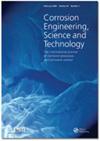Computational modelling and correlation of physical parameters of 1-heptatriacotanol, phytol and 3, 7, 11, 15-tetra methyl-2-hexadecen-1-ol with the corrosion inhibition efficiency of CIW for mild steel in HCl
IF 1.5
4区 材料科学
Q4 MATERIALS SCIENCE, MULTIDISCIPLINARY
Corrosion Engineering, Science and Technology
Pub Date : 2023-01-12
DOI:10.1080/1478422X.2023.2165238
引用次数: 0
Abstract
ABSTRACT Aqueous leaves extract of Clerodendrum infortunatum (CIW) was used as inhibitor for mild steel corrosion in 0.5 N HCl. Inhibition efficiency decreases with temperature. The presence of 1-heptatriacotanol, the diterpene alcohols like phytol and 3, 7, 11, 15 tetramethyl-2-hexadecen-1-ol are identified as major constituents through GC-MS analysis of CIW. The electronic properties and inhibition efficiency of these compounds were evaluated using DFT and material studio software. The donor–acceptor type interactions resulting from the migration of lone pair of electrons of the ‘O’ atom of these molecules to the vacant ‘d’ orbital of the metal is evident from these calculations. The reduction in the double-layer capacitance with the incremental addition of CIW is noticed. CIW offers mixed inhibition with anodic predominance. CIW forms a multimolecular layer on the metal surface obeying the Temkin isotherm model. Surface perturbations were followed qualitatively by SEM, stereomicroscope and XPS.1-庚三醇、植物醇和3,7,11,15-四甲基-2-十六碳烯-1-醇物理参数与CIW在HCl中对软钢的缓蚀效率的计算模型和相关性
摘要:采用Clerodendrum infatunatum(CIW)的水性叶提取物作为缓蚀剂,在0.5N盐酸中缓蚀软钢。抑制效率随温度的升高而降低。通过CIW的GC-MS分析,确定了1-庚三醇、二萜醇如植物醇和3,7,11,15四甲基-2-十六碳烯-1-醇的存在是主要成分。使用DFT和material studio软件评估了这些化合物的电子性质和抑制效率。从这些计算中可以明显看出,这些分子的“O”原子的孤对电子迁移到金属的空位“d”轨道所产生的施主-受主型相互作用。注意到随着CIW的增加双层电容的减小。CIW具有阳极优势的混合抑制作用。CIW在金属表面形成多分子层,遵循Temkin等温线模型。用SEM、立体显微镜和XPS对表面扰动进行了定性跟踪。
本文章由计算机程序翻译,如有差异,请以英文原文为准。
求助全文
约1分钟内获得全文
求助全文
来源期刊

Corrosion Engineering, Science and Technology
工程技术-材料科学:综合
CiteScore
3.20
自引率
5.60%
发文量
58
审稿时长
3.4 months
期刊介绍:
Corrosion Engineering, Science and Technology provides broad international coverage of research and practice in corrosion processes and corrosion control. Peer-reviewed contributions address all aspects of corrosion engineering and corrosion science; there is strong emphasis on effective design and materials selection to combat corrosion and the journal carries failure case studies to further knowledge in these areas.
 求助内容:
求助内容: 应助结果提醒方式:
应助结果提醒方式:


